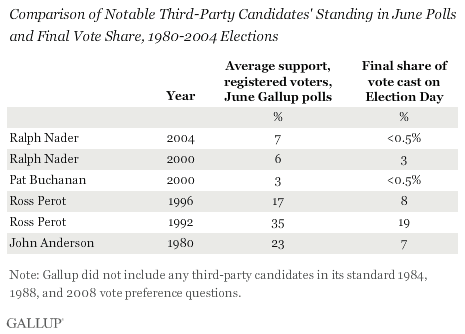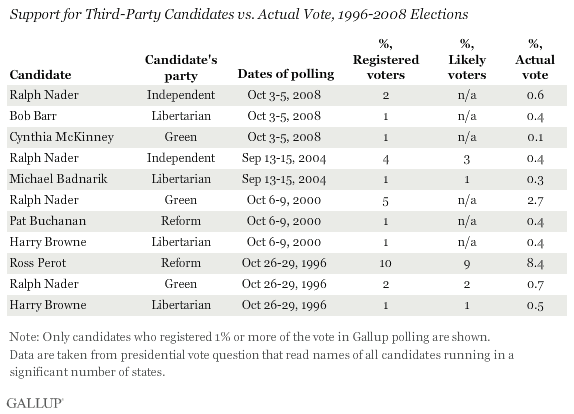PRINCETON, NJ -- U.S. registered voters show limited support for third-party candidates this year, with the vast majority preferring Barack Obama or Mitt Romney. A June 7-10 Gallup poll asked a special presidential preference question, listing three third-party candidates in addition to Obama and Romney. Libertarian presidential nominee Gary Johnson is the choice of 3% of registered voters and Green Party candidate Jill Stein the choice of 1%. Another 2% volunteer Ron Paul's name and 1% mention someone other than the listed candidates.
![I'm going to read a list of five candidates for president who may appear on the ballot in a significant number of states this November. Supposing that all of these candidates were on the ballot in your state, which one would you be most likely to vote for -- [ROTATED: Barack Obama, the Democratic candidate, Mitt Romney, the Republican candidate, Gary Johnson, the Libertarian Party candidate, Jill Stein, the Green Party candidate, Virgil Goode, the Constitution Party candidate,] or will you be voting for someone else? (Asked of those who are undecided) As of today, which one of these candidates do you lean toward?](http://content.gallup.com/origin/gallupinc/GallupSpaces/Production/Cms/POLL/zv4dwarhbesvv-skk1bbgq.gif)
Gallup periodically asks a vote preference question during presidential election years, in which interviewers read the names of all candidates who will appear on the ballot in a large number of states, as one way of measuring third-party support. These findings reflect Gallup's first such measurement in 2012. The resulting data suggest 5% of U.S. voters could vote for a third-party candidate this year, which could rise if Paul changes course and runs as an independent.
The standard presidential preference question included in Gallup Daily tracking mentions only Obama and Romney by name and finds a consistent 1% volunteering the name of some other candidate as their choice for president. The 1% is in line with the vote for third-party candidates in recent presidential elections when no high-profile third-party candidate (like Ross Perot in 1992 and 1996, and Ralph Nader in 2000) ran.
Prominent third-party candidates have tended to receive significantly higher support in polls taken earlier in election years than they wind up getting on Election Day. This is based on a comparison of registered voter preferences in June with the final election vote share in years when higher-profile third-party candidates were included in Gallup's presidential preference questions. In general, the candidates wound up getting a fraction of their June estimated support -- in most cases, less than half.

The drop in support during the campaign is likely due to two factors. First, historically, third-party candidates' support typically drops as the campaign approaches Election Day, perhaps because voters realize the candidates have little chance to win. Second, generally speaking, support for third-party candidates tends to be higher in the broader pool of registered voters than in the smaller group of actual voters.
Lower-profile third-party candidates also tend to receive higher support in preference polls when included in the list of candidates than they receive in the actual vote. Gallup has asked the vote-choice question that includes minor-party candidates in each election year since 1996, including in the fall, when Gallup begins measuring likely voters' preferences. In every instance, the available registered and likely voter estimates exceeded the actual percentage of the vote the candidate received in the election.

Thus, the 5% to 7% currently mentioning support for a third-party candidate is likely an upper boundary estimate, given the historical performance of minor-party candidates and the tendency of their support to be overstated when they are included in presidential preference polls.
Third-Party Vote Likely Helps Obama
With Gallup's daily horse-race ballot generally showing a competitive race between Romney and Obama -- the two are tied at 46% of the vote among registered voters since Gallup began its tracking program in April -- it is interesting to note that much of the third-party vote seems to be coming at Romney's expense. Romney's 40% share of the registered voter total in this ballot format in the June 7-10 survey is significantly below his average in tracking to date, while Obama's 47% vote share is more in line with his typical performance.
This is not unexpected in a year in which an incumbent president is running, when voters' decisions center largely on the president's performance and whether he deserves a second term, as opposed to choosing from a set of candidates they prefer to be president.
Implications
With no high-profile third-party candidate entering the presidential race thus far, the third-party vote for president is likely to be limited this year. At most, 5% to 7% of U.S. registered voters currently say they would vote for someone other than Obama or Romney. However, as the historical data suggest, that percentage is likely an upper limit, given the drop in support for third-party candidates over the course of the campaign and the tendency for polls to overestimate such candidates' support when they are included in presidential preference questions.
It is not out of the question that a third-party candidate could do well enough in a particular closely contested state to tip the balance to either Romney or Obama. However, it does not appear at this point as if any of the current third-party candidates are likely to be a factor in the race on a national basis.
Survey Methods
Results for this Gallup poll are based on telephone interviews conducted June 7-10, 2012, with a random sample of 899 registered voters, aged 18 and older, living in all 50 U.S. states and the District of Columbia.
For results based on the total sample of registered voters, one can say with 95% confidence that the maximum margin of sampling error is ±4 percentage points.
Interviews are conducted with respondents on landline telephones and cellular phones, with interviews conducted in Spanish for respondents who are primarily Spanish-speaking. Each sample includes a minimum quota of 400 cell phone respondents and 600 landline respondents per 1,000 national adults, with additional minimum quotas among landline respondents by region. Landline telephone numbers are chosen at random among listed telephone numbers. Cell phone numbers are selected using random-digit-dial methods. Landline respondents are chosen at random within each household on the basis of which member had the most recent birthday.
Samples are weighted by gender, age, race, Hispanic ethnicity, education, region, adults in the household, and phone status (cell phone only/landline only/both, cell phone mostly, and having an unlisted landline number). Demographic weighting targets are based on the March 2011 Current Population Survey figures for the aged 18 and older non-institutionalized population living in U.S. telephone households. All reported margins of sampling error include the computed design effects for weighting and sample design.
In addition to sampling error, question wording and practical difficulties in conducting surveys can introduce error or bias into the findings of public opinion polls.
View methodology, full question results, and trend data.
For more details on Gallup's polling methodology, visit www.gallup.com.
